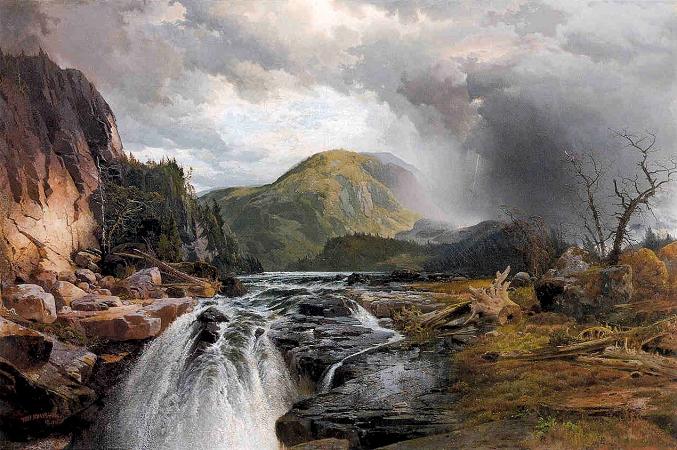Thomas Moran (1837 - 1926). Thomas Moran was an American painter and printmaker of the Hudson River School in New York whose work often featured the Rocky Mountains. Moran and his family, wife Mary Nimmo Moran and daughter Ruth, took residence in New York where he obtained work as an artist. He was a younger brother of the noted marine artist Edward Moran, with whom he shared a studio. A talented illustrator and exquisite colorist, Thomas Moran was hired as an illustrator at Scribner's Monthly. During the late 1860s, he was appointed the chief illustrator for the magazine, a position that helped him launch his career as one of the premier painters of the American landscape, in particular, the American West. Moran along with Albert Bierstadt, Thomas Hill, and William Keith are sometimes referred to as belonging to the Rocky Mountain School of landscape painters because of all of the Western landscapes made by this group. Thomas Moran began his artistic career as a teenage apprentice to the Philadelphia wood-engraving firm Scattergood & Telfer. Moran found the engraving process tedious and spent his free time working on his own watercolors. By the mid-1850s he was drawing the firm's illustrations for publication rather than carving them. It was then that he encountered illustrated books that included examples of the work of British artist J. M. W. Turner, who was to be a lasting influence on Moran's work. He also began studying with local painter James Hamilton. Moran traveled to England in 1862 to see Turner's work. From that point on, he emulated Turner's use of color, his choice of landscapes, and was inspired by his explorations in watercolor, a medium for which Turner was particularly well-known. During the 1870s and 1880s, Moran's designs for wood-engraved illustrations appeared in major magazines and gift oriented publications. Although he mastered multiple printing media including wood-engraving, etching, and lithography, which he learned from his brothers, he received renown for his paintings in oil and in watercolor. The height of his career coincided with the popularity of chromolithography, which Moran used to make color prints of his works, so that they could be widely distributed. He was also one of the leaders of the etching revival in the United States and Great Britain. Moran was married to Scottish born Mary Nimmo Moran, an etcher and landscape painter. The couple had two daughters and a son. His brothers Edward, John and Peter, as well as his nephews Edward Percy Moran and Jean Leon Gerome Ferris were also active as artists. He died in Santa Barbara, California on August 25, 1926. Thomas Moran's vision of the Western landscape was critical to the creation of Yellowstone National Park. In 1871 Dr. Ferdinand Hayden, director of the United States Geological Survey, invited Moran, at the request of American financier Jay Cooke, to join Hayden and his expedition team into the unknown Yellowstone region. Hayden was just about to embark on his arduous journey when he received a letter from Cooke presenting Moran as an artist of Philadelphia of rare genius. Funded by Cooke, and Scribner's Monthly, a new illustrated magazine, Moran agreed to join the survey team of the Hayden Geological Survey of 1871 in their exploration of the Yellowstone region. During forty days in the wilderness area, Moran visually documented over 30 different sites and produced a diary of the expedition's progress and daily activities. His sketches, along with photographs produced by survey member William Henry Jackson, captured the nation's attention and helped inspire Congress to establish the Yellowstone region as the first national park in 1872. Moran's paintings along with Jackson's photographs revealed the scale and splendor of the beautiful Yellowstone region where written or oral descriptions failed, persuading President Grant and the US Congress that Yellowstone was to be preserved. Moran's impact on Yellowstone was great, but Yellowstone had a significant influence on the artist, too. His first national recognition as an artist, as well as his first large financial success, resulted from his connection with Yellowstone. He even adopted a new signature: T-Y-M, Thomas Yellowstone Moran. Just one year after his introduction to the area, Moran captured the imagination of the American public with his first enormous painting of a far-western natural wonder, The Grand Canyon of the Yellowstone, which the government purchased in 1872 for $10,000. For the next two decades, he published his work in various periodicals and created hundreds of large paintings. Several of these, including two versions of The Grand Canyon of the Yellowstone and Chasm of the Colorado are now on view at the Smithsonian American Art Museum. Over the next forty years Moran traveled extensively.
more...














